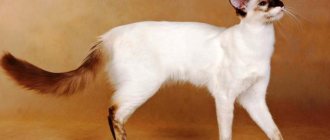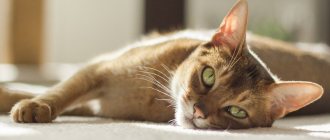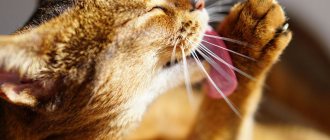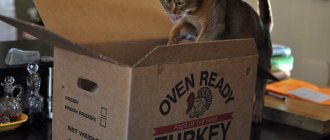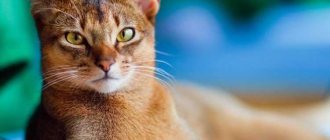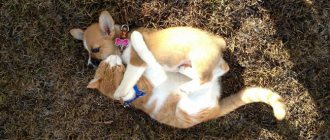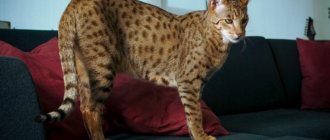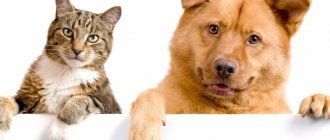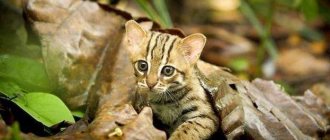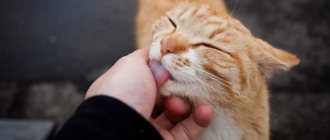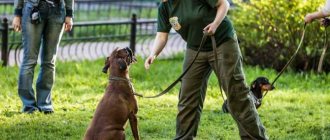Hello, dear readers!
I am glad to welcome you to the pages of the “Cat City” blog.
Today we’ll talk about the exotic murka, which in the past could only live in the family of the Pharaoh and his close people. For many years, this descendant of the royal pets was an indicator of the status in society, wealth and prosperity of the owner and his family. After all, the cat cost a lot of money. This descendant is an Abyssinian cat: photos, colors and its description are of interest to many novice cat breeders.
Origin story
Scientists have established that the first images of Abyssinian cats are depicted on tablets in the tombs of Egyptian pharaohs. They belonged only to them and their relatives - ordinary Egyptians did not have the right to keep these graceful and majestic animals. As the name suggests, the birthplace of the breed is ancient Abyssinia, which is now called Ethiopia. Thus, the history of the breed lasts exactly as long as our civilization exists.
From Egypt in 1907, two representatives of the breed were brought to America. The Second World War almost interrupted the breeding work, but the unique Abyssinians were preserved. Unlike adults, small kittens are clumsy and acquire a royal gait only with age.
Health and breed diseases
The Abyssinian breed has good health, it is not for nothing that they have been preserved from such ancient times. Abyssinian kittens rarely get sick, but hereditary diseases are observed:
- retinal atrophy – leads to complete blindness;
- polycystic kidney disease – the kidneys stop working;
- blood diseases - the process of red blood cell production is disrupted;
- psychogenic alopecia – hair loss due to stress.
Acquired diseases that occur in the breed include:
- hyperesthesia syndrome - occurs against the background of a nervous disorder;
- hip dysplasia – develops in old age;
- gingivitis – gums become inflamed;
- indigestion - occurs due to improper feeding.
To protect Abyssinian cats from common infectious diseases, they must be vaccinated. The breed is susceptible to leukemia, which is incurable. Only vaccinations can protect against it.
Advantages and disadvantages
Experts highlight the following advantages of the breed:
- sophistication in every movement;
- smart;
- active and inquisitive;
- friendly with children and other animals;
- rare coat color, different from its relatives.
The disadvantages of Abyssinians include:
- naturally cautious;
- do not like to sit on the owner’s lap, preferring elevated places in the apartment;
- love to play mischief;
- They cannot be without their owner for a long time.
Caring for the Abyssinian coat
Abyssinian cat, photo by S. Voskresenskaya
Fortunately, most owners of Abyssinian cats do without even brushing, preferring to simply run wet hands or a special rubber mitten over the cat’s fur from time to time. The Furminator tool for short-haired cats will help you quickly and easily comb your cat - its teeth effectively remove dead hair without harming healthy, living hairs or scratching the animal’s skin.
Bathing your Abyssinian cat with a special shampoo and conditioner will help your pet get rid of dead hair faster. If an Abyssinian has been accustomed to bathing since childhood, the bathing day will be easy and painless for both the pet and the owner. After washing, it is best to use a hairdryer, but if the Abyssinian is frightened by its loud sound, at least dry the fur with a towel as much as possible and protect the pet from drafts until it is completely dry.
If hair loss is too intense for no apparent reason, you should consult a veterinarian - perhaps your pet is not in good health or is lacking some substances.
Description, appearance, standard, color
Abyssinians differ from their relatives in their plastic body, rare color, small size and weight, as well as leanness. They have large almond-shaped eyes and a very intelligent look.
The weight of animals does not exceed 4 kg for females and 6 kg for males. Life expectancy is 15-20 years. Also read about how many years cats live.
Breed standards:
- Height – no more than 30 cm for cats and 35 cm for cats.
- Wedge-shaped head, elegant neck, wide ears and located at a considerable distance from each other.
- One of the features is the rim around the entire perimeter of the eyes, the color of which can be either green or amber.
- Long paws and tail, narrow oval shaped paw pads.
- The body is covered with smooth, short, thick fur, which has four permitted colors: fawn, wild, blue and sorrel.
Characteristics of colors
The fawn or “fawn” color is manifested by a light brown shade of fur with markings reminiscent of the color of cocoa.
Wild is recognized as the most common and comes in all shades of ocher; kittens are born with black markings on the face and tip of the tail.
Sorrel is a cinnamon red color. Cats of this color have a reddish-red hue with chocolate markings on the face and tail.
Blue Abyssinians have warm beige and gray coats with slate gray markings.
Pros and cons of the breed
Like cats of any other breed, Abyssinians have both advantages and disadvantages.
| pros | Minuses |
| Cleanliness | Tendency to depression |
| Friendliness | High probability of infertility in cats |
| Playfulness |
Abyssinian cats are beautiful and very active animals that do not require special care. Representatives of the breed quickly get used to their owners and try to follow on their heels. Therefore, Abyssinians are the best choice for those who like loyal and sociable pets.
Character
Abyssinian cats are very dynamic animals. Therefore, when choosing this breed, the future owner must take into account this need of the pet and provide it with a platform for outdoor games and active walks in the fresh air.
If this is not done, you may encounter unpleasant consequences in the form of overturned flower pots and scratched furniture.
They also choose an owner once and for life. It will be difficult for a stranger or other family member to gain the animal's trust. The natural curiosity in the character of Abyssinian cats pushes them to do everything together with the owner - play football, watch TV, clean, do laundry, and so on. At the same time, cats manage to walk around their property and keep order both inside and outside the house. Experts recommend hiding toys from time to time so that they are new every time.
Emotionality in behavior and irrepressible temperament do not allow representatives of this breed to sleep peacefully, like most of their relatives, and even more so to spend time on the owner’s lap. According to reviews from numerous owners, the maximum that Abyssinian cats can do is one minute and then run and watch the world.
Abyssinians, due to their intelligence and resourcefulness, and love of mischief, can organize peculiar cat clowneries at home. They definitely won’t let their household get bored. They are excellent companions for children and other animals.
Buy an Abyssinian cat
A few simple recommendations will help you avoid making mistakes when buying kittens:
- Chat with the breeder and get complete information about the pedigree and health of the future pet.
- Do not adopt a kitten younger than two months. The recommended age for transition to a new family is 3-4 months.
- Remember the documents and veterinary book that the seller must provide to the buyer.
How to choose a kitten
When choosing a future pet, you need to carefully examine the entire litter and observe its behavior. Signs of a healthy pet are active behavior and lack of fearfulness.
Pay attention to the coat: it should be smooth and clean, without bald spots or unpleasant odor. There should also be no skin rashes, scratches or scabs. The ears are clean and undamaged. The stomach should not be bloated.
Abyssinian kittens up to 4 months of age have gray-blue eyes. Later it changes to yellow or green.
Cost of the Abyssinian breed
A purebred healthy Abyssinian kitten cannot be cheap. We recommend contacting professional breeders or nurseries. The cost of a kitten as a pet varies between $300-500 (20,000-35,000 rubles). Such animals are given away with the condition of further sterilization or castration. The price for Abyssinian kittens for breeding purposes will cost from $1,000 (from 60,000 rubles). The price is influenced by the gender of the kitten, its color and build, the title of the parents and the prestige of the nursery.
Abyssinian catteries
Addresses of some nurseries in the capitals of the CIS.
Russia Moscow: savageru.ru St. Petersburg: omniamea-spb.ru Magnitogorsk: aschi.ru Samara: sunny-savage.ru
Belarus (Minsk): www.fierycristal.by
Kazakhstan (Saran): deti-solntsa.kz
Ukraine (Kiev): sunrise-aby.com
Care and maintenance, nutrition
In order for Abyssinian cats to be healthy, several important conditions must be met:
- Strictly follow the vaccination schedule in order to avoid infection with dangerous infections such as rabies.
- Give balanced feeds. Read about a healthy cat diet.
- Arrange water treatments.
- Carry out deworming regularly.
Maintenance is not difficult. Due to their short and smooth coat, Abyssinian cats practically do not shed, so brushing them once a week is enough. Read about what to do if your cat starts shedding. At the same time, a constant and comfortable temperature regime is necessary in a house or apartment so that the pet does not become overcooled. Abyssinians learn to use the toilet easily and quickly.
The best fillers for the tray are pellets and sawdust.
Abyssinians are not afraid of water procedures, but they take better care of their teeth and gums with the help of a special paste and brush. Read how to brush your cat's teeth at home. It is also necessary to check the ears and eyes, removing dirt as necessary. If the animal does not sharpen its claws sufficiently on its own, then it is better to trim them with special tongs no more than once a month.
Education and physical activity
Abyssinian cats are curious and energetic animals. They try to explore every corner of the house and love to climb on cabinets. To give the Abyssinians the opportunity to splash out their accumulated energy, they are equipped with a play complex with numerous shelves and ladders on which the pet can climb and jump.
Representatives of this breed are distinguished by high intelligence and extraordinary cleanliness. They quickly get used to the rules established in the house and remember their own nickname.
Abyssinians are able to learn commands and can repeat the actions of their owners.
Nutrition
For Abyssinian cats, both dry food and canned food from leading cat food manufacturers, as well as natural products, are suitable.
Animals need dry food of at least premium, and preferably super premium and holistic class. Small kittens are transferred to an adult diet after they reach 10 months of age.
Natural products can and should be included in the feeding process of both a kitten and an adult. The main thing is that the meat and fish are boiled or well frozen and without bones. Eggs are allowed both raw and boiled to enrich cottage cheese or cereal porridge.
Prohibited Products
A sample diet looks like this:
- Once a week by-products, chicken or beef;
- 1-2 times a month sea fish;
- every 2-3 days beef;
- chicken can be given every other day;
- for small kittens cream or milk daily;
- weekly for adult cats - kefir or fermented baked milk;
- 2 times a week boiled yolk;
- for small kittens under 12 weeks of age, liquid porridge with oatmeal, semolina or rice every other day;
- 2 times a week low-fat cottage cheese mixed with a raw egg;
- 2-3 times a week, pre-boiled and chopped vegetables.
Sprouted oats and wheat can be purchased at zoological stores or grown yourself. Brewer's yeast and sunflower oil are also introduced into the diet.
Sterilization and castration
Abyssinians who are not of breeding value are best sterilized. Such an operation will protect the animal from the possible development of purulent inflammation of the uterus and other health problems. An Abyssinian cat can be sterilized after puberty and only in a veterinary clinic.
Important. Too early surgery is fraught with problems with the genitourinary system. Therefore, it is advisable to carry it out after the Abyssinian turns 5-6 months old.
Food prohibitions
In addition to healthy foods, there are also those that are strictly not recommended to be included in food:
- Chicken and fish bones, since cats cannot chew them, and the bone can injure both the gum and tooth.
- Raw meat - duck, goose, pork. Fatty lamb is also contraindicated.
- Smoked meats in any form, as well as seasonings, spices and salt.
- Marinades and fried foods.
- All legumes are excluded from vegetables: peas, soybeans, beans, and potatoes.
Read about what cats and kittens should not eat.
Uncontrolled use of the above products affects the pet's immunity and the appearance of its coat - it becomes dull and dandruff may appear. Legumes can cause gas and stomach upset.
If the cat receives only natural food, then it is necessary to additionally introduce vitamins and supplements, since ordinary products do not contain the full range of necessary substances.
Also read the article about whether cats can be fed raw foods.
Diseases of Somalia
Purebred Somalis are distinguished by good health and on average live at least 11-16 years, and with good care and favorable conditions their life expectancy can reach 20 years. However, like most purebred cats, these animals are susceptible to some genetic pathologies. Most often, owners of Abyssinian longhairs encounter the following diseases:
- Periodontal disease. It can be suspected by a sharp decrease in appetite and uncharacteristic behavior of the pet. A sick cat often shakes its head, rubs its muzzle with its paw, as if trying to get something out of its mouth, slurps and grinds its teeth when chewing, and refuses its favorite solid food, preferring wet food. The animal experiences increased salivation (sometimes mixed with blood or pus) and a strong putrid odor from the mouth. If you notice the described symptoms, it is important to immediately contact a veterinarian - otherwise the cat risks losing all its teeth, acquiring a whole bunch of diseases (gastritis, dysbacteriosis, kidney failure) or even dying.
- Hyperesthesia syndrome, or neurosis. This term refers to severe depletion of the nervous system caused by severe and/or prolonged stress. An animal in this state often displays causeless aggression or licks itself for hours on end, bringing itself to the state of a “wet hedgehog.” The specific causes of hyperesthesia are still unclear, but the manifestations of the pathology are usually eliminated with sedatives prescribed by a specialist. The disease cannot be neglected, as this can lead to catatonia or coma.
- Dislocation of the kneecap. It is less common than others and usually occurs as a result of mechanical injuries. The animal limps, often sits down while walking, and may scream in severe pain. If the cause of the disease lies in a genetic defect, signs will appear slowly, but gradually develop into permanent lameness. The diagnosis is confirmed by radiographic examination. Dislocation of the kneecap requires drug treatment (vitamins, aminoglycosides, NSAIDs), and in advanced cases, surgical intervention.
- Retinal atrophy. A hereditary disease that is asymptomatic up to a certain point. As the pathology develops, the cat owner may notice dilation of her pupils, clouding of the lens of the eye, and a reluctance to move in the dark or in unfamiliar surroundings. Retinal atrophy is a genetic disorder that cannot be cured.
- Amyloidosis of the kidneys. A severe metabolic disorder in which a pathological protein (amyloid) is deposited in the liver, kidneys or pancreas. The disease is considered hereditary, but in some cases it can develop as a result of an infectious pathology or severe food poisoning. A sick cat has yellowness of the skin and all visible mucous membranes, loss of appetite, apathy, deterioration of the coat and digestive problems. Amyloidosis is dangerous because the animal loses a lot of substances valuable to the body, becoming susceptible to a number of severe pathologies - for example, thrombosis of veins and arteries, ascites, anorexia and renal failure. The disease is considered incurable, but with timely diagnosis, stable remission can be achieved, providing the pet with a fairly good quality of life.
Abyssinian longhair cats, better known as Somalis, are loyal and intelligent animals that can brighten up your leisure time and become excellent companions. However, representatives of the breed need special care and attention, so you need to think carefully before getting such a pet.
Mr. Cat Warns: Cat Allergy
Abyssinian cats have less fur than other breeds, so they practically do not shed. But this does not make them hypoallergenic, since in people allergic reactions can be caused not only by fur, but by the saliva and urine of the animal.
In terms of the internal structure and functioning of glands and hormones, Abyssinians are no different from their relatives - they also actively lick themselves, and the urine of males is richer in smell than the urine of females. Therefore, if the future owner is allergic to cats of other breeds or ordinary outbreds, then it can also manifest itself in Abyssinians.
Interesting Facts
Over the years of the breed’s existence, a lot of interesting things have happened to it:
- According to the CFA, in 2012, Abyssinian cats took second place in the popularity rating of Europe and America among short-haired breeds.
- After World War II, animals were on the verge of complete extinction. The breed was restored thanks to individuals that came to the United States in the early 1900s.
- The Abyssinian is one of the few cats that love water and tolerate bathing procedures without fear.
Abyssinian kittens of wild color - a charming savage
Photo of an Abyssinian kitten from the Abysphere nursery.
This is the most common color option among Abyssinians; the word ruddy is translated from English as “ruddy.” Wild Abyssinian kittens have a brown-ocher undertone combined with black or dark brown ticking. A contrasting dark line runs along the back, ending at the tip of the tail, which has the most intense color. The nose is terracotta colored and has a dark edging, and the paw pads are ticked in color.
External features
Abyssinian cats are quite miniature, their weight on average ranges from 4.5 to 8 kg. The breed standard is the same, but breeders note that there is a trend towards differences between the American and European types of Abyssinians:
- American Abyssinians are larger and have shorter hair. Eye set is closer;
- European - harmoniously built, proportional, have a characteristic “smile” and a more saturated color.
Felinological associations are developing breed standards, rules for their evaluation and establishing the timing and procedure for holding cat shows. In Russia, the following associations most often hold exhibitions:
- CFA,
- TICA
- FIFe,
- WCF.
The breed standard in different felinological associations is prescribed with slight differences, which arise mainly due to the description of the same property in different words. There are obvious similarities in several Abyssinian standards:
- The body is muscular and flexible, of medium length: in cats - approximately 32 cm, and in cats - 28 cm.
- the neck is long and graceful.
- the tail tapers from the base to its tip.
- the forelimbs and hind limbs are long, slender and thin.
- the head is blade-shaped with large, wide ears.
- the eyes are almond-shaped with a pronounced black rim. Most often the eye color is green or amber.
- chin is strong.
- nose of medium length.
- short coat, lying close to the body, shiny and smooth. It is noteworthy that each hair is colored in 2-3 different colors. This phenomenon is called ticking. Thanks to it, the cat's fur seems to shimmer in the light.
The main differences in the standard between different associations include:
- TICA stipulates that males are larger than females and notes that the Abyssinian type is somewhat unusual; FIFe and WCF do not have such a section in the standard at all.
- CFA, TICA: Abyssinians value not size, but proportionality and overall harmony. FIFe and WCF are strict about size;
- TICA: The length of the coat falls from the back to the head and legs. A coat that is too smooth is not welcome, as is one that is too fluffy;
- a round head or a long narrow head, like a Siamese, is a fault in the CFA, a disqualifying feature in the FIFe. TICA and WCF are generally silent about this;
- for FIFe, WCF, ear tassels are desirable;
- The CFA prefers a broad forehead.
Currently, there are officially 4 colors of Abyssinian cats:
- wild (ruddy);
- red, or sorrel (red) - copper-red with chocolate brown;
- blue (blue);
- beige (fawn) - warm pink with beige.
Different associations have some differences in color standard requirements:
- FIFe: dark ends of hair are preferable. Along the spine the fur is darker. White is allowed only above the lips, at the nose and from the chin to the neck, but not going onto the chest;
- TICA will disqualify you for reverse ticking (the tip of the hair is light, not dark). The back may be darker in color. White around the nostrils, on the chin and at the top of the throat;
- WCF: triple ticking is preferable. The line along the spine (dorsal strap) ... is intensely ticked in color. White should not go beyond the chin;
- CFA: More saturated shades are welcome, but the intensity of the ticking should not be sacrificed in favor of color saturation. TICA: More saturated shades are preferred, it is specifically stipulated that the dark color between the toes extends slightly beyond the sole. The back can be colored darker - this is permissible if the fur on it is completely ticked. White around the nostrils, on the chin and at the top of the neck.
Blue Abyssinian kitten - mountain lion
Photo of an Abyssinian kitten from the Incendie Etoile cattery.
The soft blue color in the case of the Abyssinian breed is a lightened version of the wild color. The blue Abyssinian kitten is incredibly beautiful - the lower part of the body is colored pinkish-fawn, and the upper part is gray-blue. The dark stripe on the back is a deeper shade of blue. The nose is the color of a dusty rose, and the pads of the paws are purple, with a bluish edging between the toes.
